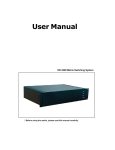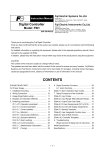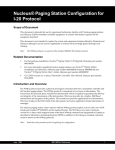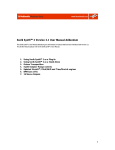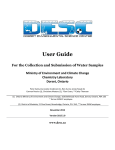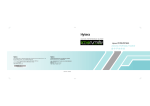Download PTX-150 - Brad Dye
Transcript
Sonik PTX-150 PTX-150 DIRECT DIGITAL PAGING TRANSMITTER Sonik Technologies Corporation User Manual Version C2 October 2000 Sonik Technologies Corporation 2310 Cousteau Ct Vista, CA 92083 Ph: 760-536-1000 Fax: 760-536-1024 email: [email protected] Sonik PTX-150 CONTENTS 1. INTRODUCTION .................................................................................. 1 1.1 GENERAL ....................................................................................................... 1 1.2 INDICATORS AND CONNECTORS................................................................ 2 1.2.1 FRONT PANEL INDICATORS...................................................................................... 2 Table1.2.1 LED indication of Transmitter status........................................................................... 2 1.2.2 REAR PANEL CONNECTORS AND SOCKETS ........................................................... 3 Table 1.2.2 Rear Panel functions................................................................................................. 3 Figure 1.2.0 Rear view ................................................................................................................ 3 1.3 DESCRIPTION OF OPERATION .................................................................... 4 Figure 1.3.1 Block Diagram of the Paging Transmitter................................................................. 4 2. SPECIFICATIONS ............................................................................... 6 Table 2.0.1 - Physical Specifications ........................................................................................... 6 Table 2.0.2 - General Specifications............................................................................................ 6 Table 2.0.3 - RF Characteristics .................................................................................................. 6 3. INITIAL INSTALLATION...................................................................... 7 4. CONNECTION TO NETWORK............................................................ 9 Table 4.0.1 List of the DB37 connector pins................................................................................. 9 5. TROUBLE SHOOTING GUIDE ......................................................... 10 Table 5.0.1 - Trouble Shooting .................................................................................................. 10 6. USING THE RDK REMOTE TX DIAGNOSTIC PROGRAM ............. 10 7. GLOSSARY OF TERMS.................................................................... 11 Appendix A: RDK Software User's Guide ............................................. 1 Appendix B: Basic Connection Between Tx and Controller ............... 1 Appendix C: Satellite Link Mode Configuration for External NIU....... 1 Doc Ref : 7M393-1 SONIK - 2000 Version C2 Sonik PTX-150 INTRODUCTION 1. INTRODUCTION 1.1 GENERAL The SONIK PTX-150 Paging transmitter is a state of the art DSP/DDS (Digital Signal Processor/Direct Digital Synthesis) based device capable of generating all paging modulation formats, and is designed as a general purpose transmitter for all speed paging systems. Construction of the transmitter is fully modular. Internally, the case is divided into compartments with PCB’s arranged in modules, all interconnected by plug/sockets. All modules can be replaced without the use of a soldering iron. Replacement modules do not require alignment or tuning. The SONIK PTX-150 transmitter incorporates a universal AC supply and can also operate from a single DC supply for battery back up operation. Software permits the option of ”Hot standby” with auto changeover initiated by software selectable fault conditions. The SONIK PTX-150 transmitter is designed for 100% duty cycle at up to 55°C ambient conditions and utilizes advanced cooling technology to maintain very low power transistor junction temperatures. This approach means assures ultra reliable power amplifier performance. The power amplifier temperature is monitored and if the temperature rises above a preset amount (35°C), the diagnostics system is alerted and the fan and cooling system is activated. The transmitter is protected by over temperature feedback control to the PA drive input and also incorporates auto fold back for high VSWR conditions. An external frequency reference input is designed to handle standard reference sources and will lock the transmitter to the external reference. An internal ±1 PPM TCXO (Temperature Compensated Crystal Oscillator) is provided as standard if no external reference is available. In POCSAG wide area systems, the carrier can be ”dithered” by what is known as a ”Black noise” algorithm, to minimize cancellation of equal amplitude carriers from adjacent transmitters. This technique has been used for at least 12 years and is superior to the Carrier offset method. High stability carriers are unnecessary for the carrier dithering technique. For high speed ERMES and FLEX systems, the carrier can be offset in 1Hz steps. Doc Ref : 7M393-1 SONIK - 2000 Version C2 Page : 1 Sonik PTX-150 1.2 INDICATORS AND CONNECTORS INTRODUCTION 1.2.1 FRONT PANEL INDICATORS Table 1.2.1 illustrates the front panel diagnostic LEDs. Each LED shows the status of selected functions of the transmitter. In the following figure, the ”CONSOLE” connector acts as the standard RS232 interface for local programming. LED POWER TX ON LOW POWER HIGH VSWR FAULT FRONT RS232 ACTIVE FUNCTION Indicates that +24VDC is available from the Power supply. Transmitter is transmitting RF power. RF output is below alarm threshold set in software. Antenna port matching is out of specifications set in software. Global fault condition in the transmitter. Refer to ‘Trouble shooting Guide’ in the handbook. Indicates that the front panel RS232 port is in use. Table1.2.1 LED indication of Transmitter status Doc Ref : 7M393-1 SONIK - 2000 Version C2 Page : 2 Sonik PTX-150 1.2.2 REAR PANEL CONNECTORS AND SOCKETS CONNECTOR N-TYPE DB9 MAINS INPUT DB37 BNC RJ11 FUNCTION The RF output of the paging transmitter The connection for the external dial modem interface 115/220VAC 50/60Hz input voltage Transmitter Controller unit connection point External reference input (5-15MHz) Internal link MODEM interface Table 1.2.2 Rear Panel functions System Ground +24V N-TYPE: RF Output RJ11: Link Modem Interface BNC: External Frequency Source Input GND DB37: LIU Interface MAINS INPUT: AC Power In & Swtch/Fuse assembly DB9: RS232, Dial MODEM Figure 1.2.0 Rear view Doc Ref : 7M393-1 SONIK - 2000 Version C2 Page : 3 Sonik PTX-150 1.3 DESCRIPTION OF OPERATION 37 pin DIN Frequency converter and mixer INTRODUCTION RF filter and preamp.Nominal 300 mW/50 ohms 20 Watt Driver Amplifier. DSP/DDS circuits, microprocessor, modulator and TCXO External Freq. standard. (optional) VCO and channel synthesizer Auto Diagnostics Circuits Power Splitter 75 Watt Power Amplifier 75 Watt Power Amplifier Combiner AC Power supply (optional) Filter RF OUT Figure 1.3.1 Block Diagram of the Paging Transmitter A block diagram of the operation of the paging transmitter is shown in figure 1.3.1. On the exciter printed circuit board, the DDS/DSP circuitry generates a 10.7 MHz modulated signal, referenced to the internal TCXO or an external reference frequency source. (The reference source is selected in a software option). The external reference is only required when stability of the carrier better than ±1PPM is required. (Parameters such as rise time, absolute deviation, mode etc are all selectable in software). The 10.7 MHz modulated signal is processed through a filter before being applied to the first mixer. The LO input to the first mixer is a high quality 235 MHz unmodulated signal with very low phase noise. The mixing products are filtered and buffered with two stages of SAW filtering, and the low side product of 224.3 MHz is then applied to the second mixer. The Second mixer LO frequency is equal to final frequency + 224.3 MHz. Channel change is effected by the VCO supplying the second mixer. Doc Ref : 7M393-1 SONIK - 2000 Version C2 Page : 4 Sonik PTX-150 The final frequency output from the second mixer is filtered, buffered and amplified to 300 mW at 50 ohms, suitable for presentation to the Power amplifier modules. Note that the TCXO of 9.6 MHz supplies the DSP, first LO and second LO to provide the accuracy required for final frequency. The DSP circuitry actually uses 38.4 MHz which is derived from a crystal at that frequency phase locked to the 9.6 MHz TCXO. Note also that for high stability options, the 9.6 MHz TCXO is replaced when an external reference signal is applied to the BNC connector at the rear of the Transmitter. Selection of this function is via software. Automatic level control (ALC) of the exciter is affected by the on board Microprocessor in the Exciter module. The Exciter output is coupled via coaxial cable to the 20W driver amplifier in a separate compartment in the chassis. The driver comprises 2 RF amplifier stages, a Harmonic filter and directional coupler for generation of forward and reverse power voltage analogs. The output of the 20W driver amplifier goes into a power splitter, and the two 90 degree out of phase output signals from the power splitter are feed into two 75W power amplifiers. The outputs of the two 75W power amplifiers are then combined to produce 100W continuous RF output power. The forward and reverse power output is also monitored using a directional coupler. The exciter microprocessor computes VSWR from the directional coupler outputs. ALC is also effected in the PA to ensure stable output for all environmental and external conditions. The transmitter is designed to operate from a single +24VDC power source with the internal AC power supply generating the required voltage. A 37 Pin DIN female socket provides the connection for Data, Clock, mode, channel change, and PTT control from an external Line interface unit. (Refer to ‘Installation Instructions’ for details regarding pin connections). If no external PTT control exists, provision is made for PTT control by the detection of incoming data on the TX DATA (Lbit) pin of the 37 way connector. (Hang time for this automatic PTT control is selectable in software). A DB9 female socket provides access for either a PSTN dial modem or a PC. The transmitter can be monitored by a central or local computer for automatic diagnostics or polling. The PC and RDK software can be used on site to reprogram parameters of the transmitter. Doc Ref : 7M393-1 SONIK - 2000 Version C2 Page : 5 Sonik PTX-150 SPECIFICATIONS 2. SPECIFICATIONS PHYSICAL Dimensions Shipping weight 19” rack mount, 7H x 18.3D in (178mm x 465mm) 40 lbs (18 kg). Table 2.0.1 - Physical Specifications GENERAL Operating voltage Operating temperature Operating humidity Modulation generation Modulation modes 110 / 220VAC±20% -15 to +55°.C 0 to 95% RH @ 50°C Discrete DSP in conjunction with DDS Chip set. POCSAG 512, 1200 or 2400 ERMES to 6400 BPS FLEX™ 2 level and 4 level at all data rates Rise and fall times default to standard settings as defined by ERMES/ FLEX™/POCSAG recommendations. External clock dependant if not in POCSAG mode. Any rate up to 6400 BPS. Up to 16 preset channels selectable by 4 channel lines. 37 pin female DIN socket provided for connection to C-net, or other network support decoders. For POCSAG connection, Clock input line is not required and only TX DATA (Lbit) line is used. Auto dial up system with WINDOWS based central station monitoring software. Analogs and digital inputs are supported by the diagnostics package. Standard alarms are also made available on 37 pin DIN socket for connection to network interfaces such as C-NET. Up to ±3000 Hz in 1 Hz steps. 0 to 40ms in 5uS steps. Modulation characteristics Modulation rates Channel switching Interface connection Diagnostics Carrier offsets Launch Time Delay Table 2.0.2 - General Specifications RF CHARACTERISTICS RF output power Frequency range Turn on time Frequency stability External frequency reference Spurious performance Adjacent channel performance 100 Watts ±0.5dB into 50Ω 138 to 174MHz <25ms from TX ON signal to full power. Standard ±1PPM (optional external high stability frequency source). From 5 to 15 MHz at any level from -10 to 0 dBm/ 50Ω. External signal can be sinusoid or square wave. Conducted and radiated spurii better than 70 dBc. Better than 70 dBc. Table 2.0.3 - RF Characteristics Doc Ref : 7M393-1 SONIK - 2000 Version C2 Page : 6 Sonik PTX-150 3. INITIAL INSTALLATION INSTALLATION The following equipment will be required to test the transmitter:1. A good quality 50Ω dummy load or 30 dB high power attenuator suitable for 150W continuous operation at 174 MHz and with a VSWR of better than 1.15:1. 2. A 486 or better PC with at least 8 Mbyte of RAM and one serial port, installed with RDK software. 3. A suitable cable to connect the serial port of the PC to the dial Modem port of the transmitter. Details of the required cable wiring are to be found in ‘CONNECTION TO THE NETWORK’ section of the manual. 4. A suitable AC lead to suit the country where the transmitter is to be tested. 5. A ”Thruline” wattmeter fitted with the appropriate insert. 6. Suitable low loss RF cables and connectors. Remove the SONIK PTX-150 transmitter from its packing case and on a clean flat surface, carefully examine the transmitter for physical damage. Pay particular attention to the rear plugs and sockets. Verify that the rear cooling fan is free to rotate and does not have packing material in it which may prevent the blades from rotating. Connect a good quality 50Ω dummy load rated for at least 150W continuous power at the frequency of operation of the transmitter; to the transmitter RF output ”N” connector on the rear panel. WARNING: ATTEMPTING TO OPERATE THE TRANSMITTER WITHOUT A PROPER LOAD CONNECTED TO THE RF OUTPUT PORT WILL VOID THE WARRANTY. The SONIK PTX-150 series Transmitters have a detailed and comprehensive test sequence programmed in and this program activates immediately power is applied to the unit. • If the beeps and light sequencing occurs as specified, then all is well. • If a dial Modem is connected, the start up sequence differs from that which would occur if a dial Modem was not connected. • With the transmitter located free of nearby objects which may block airflow through the unit, switch on the transmitter by connecting the AC power cord to the AC supply and operating the AC ON/OFF switch on the rear panel of the transmitter. Doc Ref : 7M393-1 SONIK - 2000 Version C2 Page : 7 Sonik • PTX-150 Connect a PC (fitted with RDK software) to either the front panel console or rear panel modem ports of the transmitter, activate the RDK program and verify correct connection by selecting the READ field on the Transmitter Configuration window. The screen then prompts by asking ”ARE YOU SURE”. If the PC connection and the transmitter system is operational, respond ”YES” and the transmitter parameters are read into the PC screen. NOTE: Alarm trip points and operating parameters are preset in the factory and normally there will be no need to change these. For instructions on how to change the alarm settings and status parameters, use the PC mouse to revert to the Transmitter Configuration window. Select the Alarm Settings field and note the presets. If Auto dial out functions are required (PSTN dial modem connected), use the mouse to select which alarms will initiate a dial back (Enable). A copy of all factory defaults can be saved onto hard disk by selecting the SAVE field and typing in an appropriate file name. The power up sequence is as follows 1. A tone is heard after power is applied and all front panel lights should be ON. 2. After approximately 5 seconds the LEDs on the front panel will go off in sequence starting with the FAULT and the only remaining LED left ON is POWER. 3. The tone then stops for half a second while the SONIK PTX-150 transmitter checks for a dial modem connected to the dial modem port. If no dial modem is detected then a brief tone is heard. If a dial modem is detected then a series of tones will be made by the SONIK PTX-150 transmitter to indicate that a dial modem was detected. For connections into a remote RDK network this test must pass if a dial modem is connected. 4. After an additional 5 seconds the SONIK PTX-150 transmitter will be ready for normal operation. NOTES: WHEN USING EXTERNAL TELEPHONE DIAL MODEM 1. When an incoming call is detected the buzzer will ring as an indication. 2. When a SONIK PTX-150 transmitter is connected the POWER LED blinks to indicate that the unit is on-line to the host RDK software. Doc Ref : 7M393-1 SONIK - 2000 Version C2 Page : 8 Sonik PTX-150 4. CONNECTION TO NETWORK CONNECTION Once the transmitter has been configured for the network, it is now necessary to install the unit into the station and interface to the LIU (Line Interface Unit). • Verify that the antenna lead is connected to the station antenna. Install a Thruline Wattmeter in series with the transmitter and antenna lead. • If a PSTN connection and dial Modem are available, install the dial modem and connect it to the dial Modem port (on the rear of the transmitter). Use a standard DCE to DTE RS232 interface cable (usually supplied with the dial modem). • If an external frequency reference is used, select that option in software and connect the source via a 50Ω coaxial cable and BNC male plug to the BNC socket at the rear of the transmitter. • Identify the appropriate data, clock and mode control connections from the LIU and connect them to the appropriate pins on the DB37 connector at the rear of the transmitter. The correct connections will vary depending upon the LIU used and the mode of operation. Refer to Table 4.0.1 of pin outs for the DB37 connector. PIN No. 1 5 6 7 8 11 15 16 18 19 21 22 23 26 29 30 31 LIU Name PR0 CH4 CH3 CH2 CH1 KEY LB HB CLK GND ALM10 ALM11 ALM12 ALM3 ALM6 ALM7 ALM8 FUNCTION Protocol select line Frequency select line Frequency select line Frequency select line Frequency select line Transmitter key TX DATA, TTL (L-Bit) TX DATA, TTL (H-Bit, 4-level) Clock for synchronization data Ground Reflected power alarm 2 (not used) Output power high alarm Output power alarm 2 (not used) TX Synthesizer alarm Output power low alarm 1 Reflected power alarm 1 Fan alarm Table 4.0.1 List of the DB37 connector pins. • Determine if PTT control is via the DB37 connector or will have to be automatic upon the detection of data. • If desired, check the setting for the transmitter Hang Time (time that transmitter stays keyed on after the last data transition has occurred on the TX DATA TTL [Lbit] pin). This function can be altered in software. • Connect AC power to the transmitter and note that the appropriate test cycle occurs. The transmitter is now ready to operate. Doc Ref : 7M393-1 SONIK - 2000 Version C2 Page : 9 Sonik PTX-150 PROBLEM 5. TROUBLE SHOOTING GUIDE The transmitter has a comprehensive test program which initiates on first application of power. It is important to understand the start up sequence to determine a likely fault scenario. Table 5.0.1 lists possible symptoms, and solutions to those symptoms. SYMPTOM Dial Modem connected but the system does not indicate a connection No LEDs light up or no tone heard No RF output power • • • • • • • • • POSSIBLE PROBLEM Power to dial modem is off. Cable is installed incorrectly Dial Modem has not been set up as Hayes compatible 9600,8,N,1 Mains power is off Fuse has blown on input connector faulty power supply The SONIK PTX-150 transmitter will turn off the RF output if any potentially fatal faults develop in the unit. Fault can be caused by the LIU selecting a channel that is not configured in software. If the fault LED is ON you must find out what fault is causing the problem through the diagnostic software and repair, or notify the Supplier Table 5.0.1 - Trouble Shooting 6. USING THE RDK REMOTE TX DIAGNOSTIC PROGRAM This program is used to monitor all of the transmitter functions in a real-time mode. To initialize, have a functional transmitter working then select the RDK Remote Doc Ref : 7M393-1 SONIK - 2000 Version C2 Page : 10 Sonik PTX-150 Transmitter Diagnostic icon on the PC and the program will start to run. From the opening screen, select Tx Diag and the above display will result. Each meter indicates the true state of that transmitter function and will change in real time as adjustments to that transmitter are made. Any of the functions that has a problem (when the needle is not in the GREEN area) will have its label light up RED allowing you to immediately identify the problem area. 7. GLOSSARY OF TERMS GLOSSARY This section gives an index of how different fonts are used to represent operations between the computer and the radio and the technical terms used in this manual. Window This indicates the user should be in a particular window within the RDK control program to perform a particular operation. <KEY> The < > symbols indicate a key must be pressed on the keyboard. DDS Direct Digital Synthesis DSP Digital Signal Processor ALC Automatic Level Control PC Personal Computer LIU Line Interface Unit Doc Ref : 7M393-1 SONIK - 2000 Version C2 Page : 11 Sonik PTX-150 Appendix A: RDK Software User’s Guide One set of RDK software includes 2 compressed files and one terminal application program. Running Requirements: 1) PC: 486 or above, at least 8M memory, one 1.44M floppy disk drive, one RS-232 serial port, one printer port. 2) Cable: Serial port cable with Pin2, Pin3, Pin5 on the one side connected to Pin3, Pin2, Pin5 on the other side. 3) Operating System: Windows95/98, Windows NT. I. Select item ”Comms Setup” from ”Local Setup” menu to setup local serial port. II. Click ”Tx Freq” button to set frequency values for the transmitter. The selection of different frequencies is determined by changing the input voltage level (0V or 5V) at Pin5,6,7,8 of DB37, for example, leaving Pin5,6,7,8 to be floating (5V) means the selection of the first frequency value (channel 00). III. Click ”Tx Control” button to set parameters for the transmitter: RF power, external frequency source, data polarity, PTT signal, paging protocol, etc. Comments: low level (0V) of Pin1 of DB37 means the selection of default protocol 1; while high level (5V) of Pin1 of DB37 means the selection of default protocol 2. The two default protocol settings should not be the same value at the same time Doc Ref : 7M393-1 SONIK - 2000 Version C2 Page : 1 Sonik PTX-150 so that you can select different protocol (POCSAG or FLEX) just by changing the input level of Pin1 of DB37. IV. Click ”Modem” button to configure dial-out parameters and PMD board. V. Click ”Alarms” button to set alarm limits for RF power, High VSWR, Temperature, Voltage and High Current. VI. Click ”Read” or ” Update” button to Read or Update Transmitter Parameter Settings. VII. Click ” Diagnostics” button to Diagnose the transmitter with real-time parameters (Forward Power, VSWR, Temperature, Power Voltage, PA Current and PA driver power) monitoring. VIII. Click ”Dial Remote” button to dial remote transmitter with an internal dialer. Before dialing, please be sure to set the dial MODEM parameters using the following AT commands: ATS0=1, AT&D0, AT&K0, AT&W0. Then, select item ”Modem Setup” or ”Dialer Setup” from ”Local Setup” menu to setup local dial MODEM and dialer. IX. Click ”Load” or ”Save” button to Load/Save the current transmitter settings from/to a local file. X. Click ”Terminal” button to access the terminal program. Doc Ref : 7M393-1 SONIK - 2000 Version C2 Page : 2 Sonik PTX-150 Appendix B: Basic Connection Between Tx and Controller I. FLEX Mode: (Connect to MOTOROLA External NIU) v Connection between SONIK PTX-150 Transmitter and External NIU: External NIU(TB3, TB4) Transmitter(DB37) TB3-2: Tx Clock Connected to DB37-18: Data Clock TB3-4: Tx key Connected to DB37-11: Tx Key TB3-8: GND Connected to DB37-19: Ground DB37-1 to DB37-19 TB4-2: Rx FQ1 Connected to DB37-16: Tx Data, High Bit, TTL TB4-3: Rx FQ2 Connected to DB37-15: Tx Data, Low Bit, TTL v Connection between External NIU and GPS Receiver: Ø GPS time signal: GPS Receiver External NIU (serial port, 9 Pin) (option port, 9 Pin) Pin 1 Connected to Pin 4 Pin 2 Connected to Pin 3 Pin 3 Connected to Pin 2 Pin 4 Connected to Pin 1 Pin 5 Connected to Pin 5 Pin 6 to Pin 1 Pin 6 to Pin 1 Pin 7 Connected to Pin 8 Pin 8 Connected to Pin 7 Ø GPS 1pps Signal: connected the ”1pps OUT” port of GPS receiver to the ”1Hz IN/OUT” port of External NIU with a RCA video cable. Doc Ref : 7M393-1 SONIK - 2000 Version C2 Page : 1 Sonik PTX-150 v When the transmitter needs to get external frequency source from External NIU, connect the ”REF IN/OUT” port of External NIU to the ”External Frequency Input” port of SONIK PTX-150 transmitter with a BNC cable. II. FLEX Mode: (Connect to Glenayre C2000 Controller) v Connection between SONIK PTX-150 Transmitter and External NIU: C2000 ( J4 ) J4-10: GND Transmitter(DB37) Connected to DB37-19: Ground DB37-1 to DB37-19 J4-26: TXKEY+ Connected to DB37-11: Tx Key J4-3: TD0+, Msb Connected to DB37-15: Tx Data, Low Bit, TTL J4-34: TD1+, Lsb Connected to DB37-16: Tx Data, High Bit, TTL J4-18: Data Clock+ Connected to DB37-18: Data Clock J4-7: Freq2 Connected to DB37-6: Freq2 J4-6: Freq1 Connected to DB37-7: Freq1 J4-36: Freq0 Connected to DB37-8: Freq0 v When the transmitter needs to obtain the external frequency source from C2000, connect the ”10M REF OUT” port of C2000 to the ”External Frequency Input” port of SONIK PTX-150 transmitter with a BNC cable. III. POCSAG Mode: (Connect to Glenayre C2000 Controller) Encoder Transmitter ( DB37 ) Tx Data Connected to DB37-15: Tx Data, Low Bit PTT Connected to DB37-11: Tx Key GND Connected to DB37-19: Ground DB37-1 to DB37-19 Doc Ref : 7M393-1 SONIK - 2000 Version C2 Page : 2 Sonik IV. PTX-150 POCSAG Mode: (Connect to Zetron Model 66 Controller) Model 66 Transmitter ( DB37 ) DIG DATA (pin 10) Connected to DB37-15: Tx Data, Low Bit DIG PTT N/O (pin 7) Connected to DB37-11: Tx Key GND (pin 3) Connected to DB37-19: Ground DIG PTT COM (pin 8) to GND Doc Ref : 7M393-1 SONIK - 2000 Version C2 DB37-1 to DB37-19 Page : 3 Sonik PTX-150 Appendix C: Satellite Link Mode Configuration for External NIU I. Connection between External NIU and SONIK PTX-150 transmitter: v Connect the DATA, GND and CLK output signal of satellite receiver to TB1-5(Rx Data), TB1-4(GND) and TB1-6(Rx CLK) of External NIU. II. Jumper settings of External NIU: v S15 Pin 1 is set to be ON. Others remain intact. III. Software configuration for External NIU: v The serial port settings are: COM1, 19200bps, N, 8, 1. [ 0] NIU> set link ↵ ; Link settings link = fm2 @ 9600 from digital_in [ 0] NIU> set align_type ↵ ; Synchronization mode GPS Mode: Alignment type is gps No GPS Mode: Alignment type is dir_sync [ 0] NIU> config devid ↵ ; Base station device ID. [ 0] NIU> config sysid ↵ ; System ID. [ 0] NIU> config txd ↵ ; Paging data polarity. [ 0] NIU> set maint_polarity ↵ ; Maintenance cycle polarity. [ 0] NIU> show gps ↵ ; At GPS mode, display current GPS settings. [ 0] NIU> show status ↵ ; Display current External NIU status. [ 0] NIU> show alarm ↵ ; Display alarms for External NIU. [ 0] NIU> show config ↵ ; Display current NIU system parameters. [ 0] NIU> show dipsw ↵ ; Display current NIU jumper settings. Doc Ref : 7M393-1 SONIK - 2000 Version C2 Page : 1



















